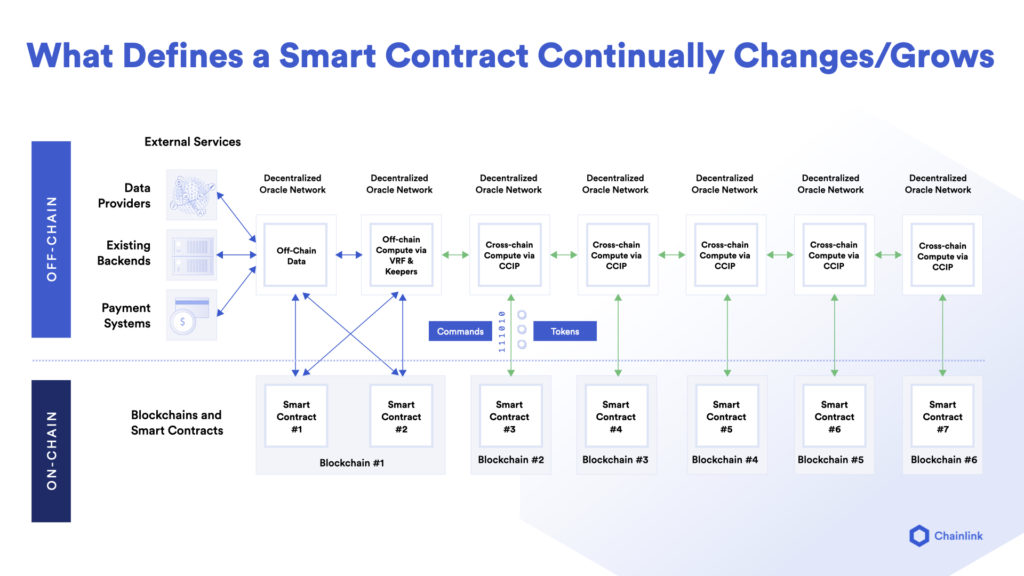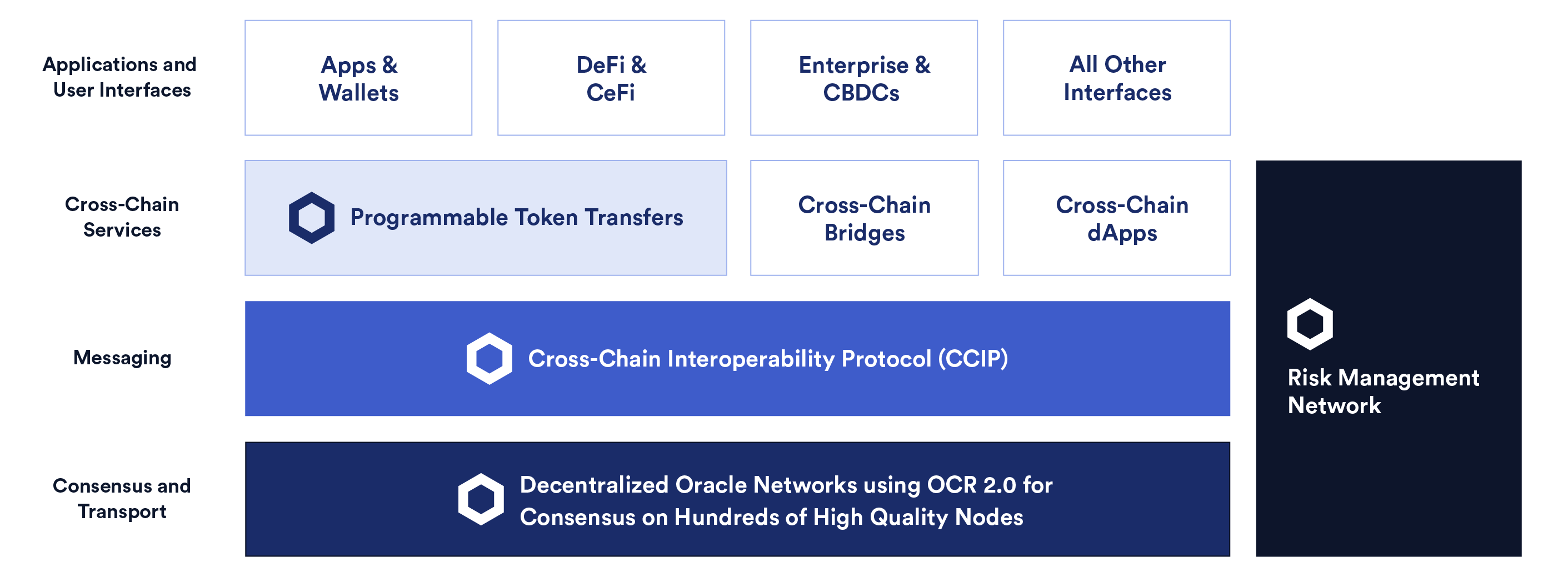Unlocking Cross-Chain Smart Contract Innovation With CCIP
In his recent presentation The Future of Chainlink, Chainlink Co-Founder Sergey Nazarov discussed the significance of the Cross-Chain Interoperability Protocol (CCIP) for the blockchain ecosystem and how it will help enable developers to build the next evolution of smart contracts that leverage the advantages of multiple blockchain networks, as well as off-chain services. Below is an excerpt from his presentation.
CCIP is the application of Chainlink’s highly secure consensus mechanism—that helps secure over $75 billion and has operated successfully for multiple years—to the problem of cross-chain communications. It is not just about moving tokens; it is actually about communications. This is the big distinction of what CCIP does.
CCIP will create many distinct bridges, and those many distinct bridges will move tokens between chains and between applications. But in the opinion of many of the people building CCIP, that is a very limited scope. Just implementing the ability to move tokens is really not enough to take our industry into a world of what we call cross-chain smart contracts.

“You will be able to generate with the emergence of CCIP a smart contract that is actually multiple contracts on multiple chains interoperating with each other.” –Sergey Nazarov
This is the third large evolution of how the definition of a smart contract will expand. The first evolution was going from one contract to two or more. The second evolution was going from multiple contracts on a single chain to those contracts using trust-minimized off-chain systems in the form of oracle networks to acquire data and to acquire computation to interface with all of those systems reliably. The third large shift and expansion in how smart contracts are going to be defined is the creation of a cross-chain smart contract composition capability.

You don’t just generate a smart contract or a set of contracts on one chain and that’s your smart contract. With the emergence of CCIP in this coming year, you will be able to generate a smart contract that is actually multiple contracts on multiple chains interoperating with each other. This will be another huge leap, similar to how the generation of price data has been a huge leap for the emergence of DeFi, and the generation of verifiable random numbers and various off-chain computations in an oracle network have caused huge improvements for NFTs and gaming.
The ability to create cross-chain smart contracts will allow developers building smart contracts to utilize various pieces of code on a wide range of different chains, just like how multiple different pieces of code are used in multiple different clouds. Web developers utilize the service and the piece of code that’s best suited for a task. That is how web applications are built, and what the Chainlink Network and ecosystem will enable developers to do by providing this cross-chain capability.
Smart contracts will have a much more useful format, known as a cross-chain smart contract. These contracts will still be hybrid smart contracts because they utilize off-chain data and computation services provided by oracle networks, whether for verifiable randomness, automation services, or other off-chain services.
“Developers will actually have the ability to build smart contract applications the same way that web developers are building high-quality web applications.” –Sergey Nazarov
At the general level, that’s what the blockchain industry, the Chainlink Network, and the Chainlink system need to accomplish to get the next million developers coming into the blockchain industry. To allow them to build the way they are used to building in the current web industry. They’re able to build high-quality applications quickly, cost-efficiently, and with easily usable applications. That is what we need to provide as an industry, an ecosystem, and a community.
While oracle networks for data provide that functionality for DeFi applications, and oracle networks for computation and random numbers provide that for gaming and NFTs, the ability to stitch together multiple pieces of smart contract code on multiple different chains is going to redefine how developers build applications in the blockchain industry. You’ll be able to use the chain that you want to use for what it’s good at. You’ll be able to use certain main chains for the security guarantees, other chains for certain speed or scalability guarantees, and even many other chains essentially as storefronts.
You’ll have multiple contracts on those chains that get value from those blockchains’ users. This will result in essentially one large smart contract, composed of multiple on-chain contracts and off-chain services that provide bridging in the form of communication, the ability to get data, and the ability to do trust minimized off-chain compute that was previously inaccessible, but necessary.

“This is the large innovation of CCIP. It creates what we feel is a cross-chain smart contract stack, with CCIP as a key protocol at the center enabling communication.” –Sergey Nazarov
That protocol can be used on decentralized oracle networks like Chainlink, and it can have key additional capabilities such as the Risk Management Network to prove that transactions going through are accurate and reliable. This will enable key innovations like programmable token bridges and various cross-chain bridges built by people in the Chainlink community and ecosystem. These cross-chain applications and smart contracts can all still be used from existing interfaces, wallets, and systems, as well as various enterprises and current web 2.0 systems.
This will complete the three categories of what the Chainlink Network and decentralized oracle networks do generally. Going from the provision of validated data to off-chain computation, and then to cross-chain communications such that you will be able to send messages between contracts for them to use each other’s services. You will be able to send tokens between contracts with minimal additional work, giving rise to cross-chain smart contracts that are enabled by highly validated data and bolstered by the ability to get random numbers, automation computations, and various other advanced computations such as FSS.
This is where the Chainlink Network is going—combatting various issues and providing clear cryptographic guarantees to users. Decentralized oracle networks provide a unique type of value to their developers and developers’ users, heralding an entirely new category of more advanced hybrid smart contracts. We’ve seen how initial versions of highly validated data, randomness, and off-chain computation jumpstart more advanced DeFi contracts, but really that is just the beginning. This can be expanded far beyond that, in the same way that the web world initially received some of its key services, which resulted in an explosion in services driven by the demand created by applications.
Start building with Chainlink today by visiting the developer documentation, joining the technical discussion on Discord, and/or reaching out to an expert.
To learn more about Chainlink, visit the Chainlink website and follow the official Chainlink Twitter to keep up with the latest Chainlink news and announcements.
